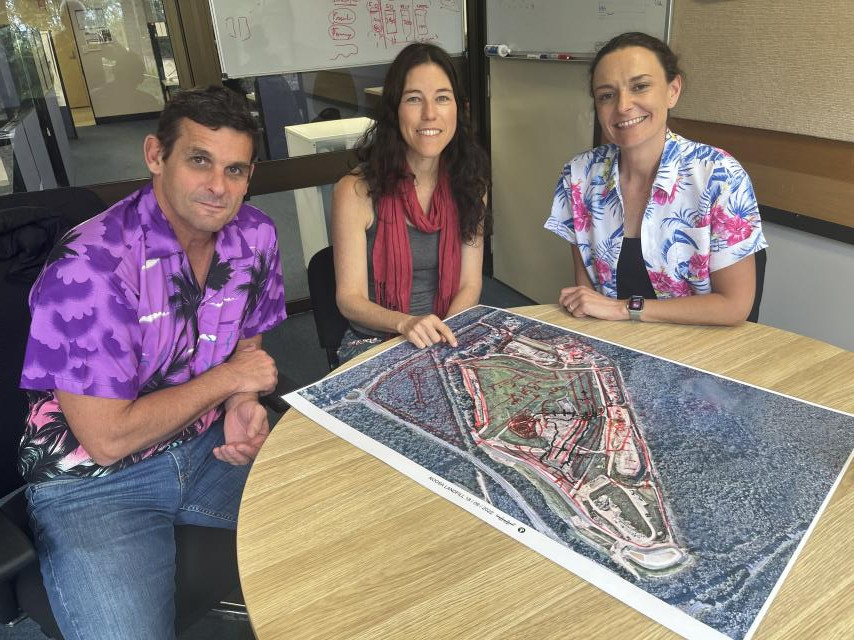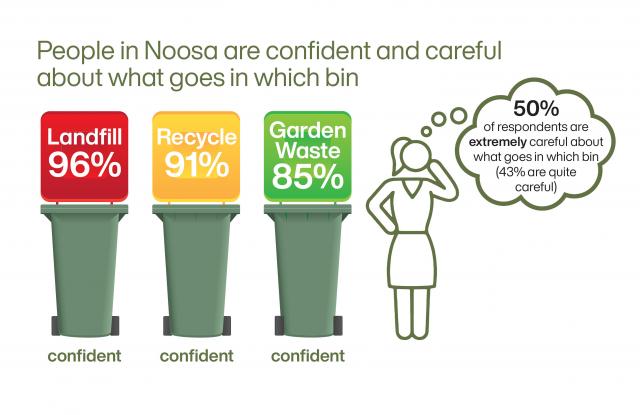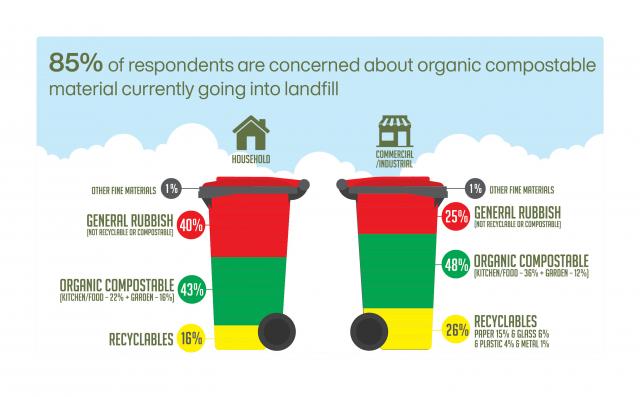“Without infrastructure you can’t do anything,” Noosa Council’s Waste and Environmental Health Manager Kyrone Dodd booms down the phone line, sounding like a man who has been fighting the budget wars for longer than he’d hoped.
But a couple of days later, clad in a bright and cheery purple aloha shirt (in readiness for an end-of-financial-year team-building afternoon over barefoot bowls) and supported by his core waste team of education and sustainability officer Peita Otterbach and project officer Jo Ferris, Kyrone is in a more expansive and explanatory mood. “It’s very difficult to change behaviours towards waste without investing first in infrastructure,” he says. “That’s particularly so for food waste, the worst element of waste because of its methane emissions, for which dealing with it requires a specific type of infrastructure, and it’s pretty much in its infancy in Queensland. We need to get that infrastructure built so we can get on with the job.”
Which in part explains the recently-completed summary of council’s waste survey, conducted over February and March, which will inform the content of the Noosa Waste Strategy, expected to be delivered by the end of the calendar year. The cost of fixing our waste problems is significant and ongoing – just two weeks ago Noosa Today reported on council approval of $227,000 for a polystyrene compaction unit – and the community needs to understand the necessity for it to get behind it. But the survey results are also significant in what they reveal about how much we’ve already learnt in a comparatively short term, which is good, however there is still so much to learn! In fact the subject of waste is so vast and overwhelming that it can be downright depressing, which is why if anyone in the Pelican Street chambers deserves to put on a silly shirt and enjoy a game of bowls, it’s the waste department.
The waste survey attracted 623 submissions, over 20 per cent more than the anticipated sample size for Noosa’s population, indicating a growing concern over the complex waste problem, and while 78 per cent of respondents thought that removing litter from our waterways was the most pressing problem – the shop window pollution you can see – 85 per cent expressed concern about organic compostable material currently going into landfill, the elephant in the room, or more or less out of sight (for the time being) on the outskirts of town.
Jo Ferris, the long-time council project officer who had most to do with the designing of the survey, told Noosa Today: “The waste survey set out to give us an understanding of what was important to the community, what their values are in relation to these issues. We need to understand what will be acceptable to them, and the results clearly showed that our community is well advanced in accepting what needs to be done. I think generally it gave us the green light to move forward. Taking personal responsibility for the fight against waste came through strongly.”
Among its many interesting findings, the waste survey revealed these key points:
• 72 per cent supported or strongly supported diverting food waste from the landfill general waste bin (red lid)
• 63 per cent reduce their personal waste by choosing products with minimal packaging
• 53 per cent compost their organic waste
• 58 per cent said their recycling bin (yellow lid) was usually full or overflowing by pickup day while 45 per cent said their organic waste bin (lime lid) was usually full or overflowing, but only 31.5 per cent said the same of their general waste (red lid) bin.
• 96 per cent were confident they knew what should go in the landfill bin and 91 per cent for the recycle bin, while 93 per cent said they were extremely or quite careful about putting their waste in the right bin.
• On a 1-10 sliding scale, 75 per cent favoured Noosa Council focussing on diverting as much waste from landfill as possible, with 25 per cent preferring to see council delivering waste services at the lowest cost to rate-payers.
Clearly there is a growing recognition in the community that above and beyond the unsightly in-your-face problem of litter on the beach and in parklands, in the waterways and at roadsides, we are drowning in our own waste. But for many people the mountain of landfill at the Eumundi Road Resource Recovery Centre is out of sight, out of mind. Says Kyrone Dodd: “It’s easy to be interested in waste when you’re in the waste department, but for most people it doesn’t figure a lot in their thought processes. When you stand at the edge and look up at this hill, it’s quite shocking to think that all of this comes from Noosa, a place that’s not very big. We’re at 30 metres high now and it can go up to 65 if we need it to. We don’t want that to happen.”
The good news is that we are seeing massive advances in recycling. The percentage of residents diverting for recycling has risen from 41 in 2021 to 52 in 2023. Says Kyrone: “We’ve moved the dial 10 per cent in a couple of years, so we’re on track to reach the Queensland target of 61 per cent by 2025.”
And yet many people don’t fully understand the multi-faceted extent of the problem nor its impact on climate change. To quote from council’s Getting Waste Sorted document: “When you put your bin at the end of the driveway to be collected each week, do you ever consider how long it takes for rubbish to breakdown? A banana peel buried at the landfill could take up to two years, a can of Coke up to 200 years, and a glass jar up to one million years! Noosa’s commercial operators and householders have been doing a fantastic job at recycling with as little as 5-6 per cent contamination in the yellow lid recycling bins (the Queensland state average is 15 per cent) [but] there is a lot of compostable organic material (kitchen scraps/garden clippings) in Noosa’s general waste bins (over 40 per cent), and when organic matter is buried in the landfill it has no oxygen and gives off methane gas emissions which are 28 times more potent than C02.”
Diverting recyclable and compostable waste from the landfill is therefore critical to our sustainable future, and while the educative process covers demographics from the oldest to the youngest, the most telling results are from the young. Says education officer Peita Otterbach: “What was glaringly obvious going through the survey responses was that there is a hunger, almost a demand, for education to ease the confusion, particularly about food packaging and what it says, and the demise of REDcycle (the failed soft plastics collection agency) has been the catalyst for a lot of that. But we’ve been doing school tours with year four students because it’s part of their curriculum. We take them around the Resource Recovery site and show them the process and try to empower them with how they can personally make a difference. And then they get in a bus and go right to the tip face and watch as stuff gets piled onto the landfill. They say things like, ‘I can see something over there that should have gone in the yellow bin!’ No filters, they’re just outraged. And they pass that on to their parents and grandparents.”
NEXT WEEK: In the concluding part of Winning on Waste, we look at the vision for the future, and how local businesses, community groups and households are responding.










